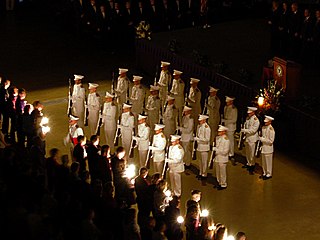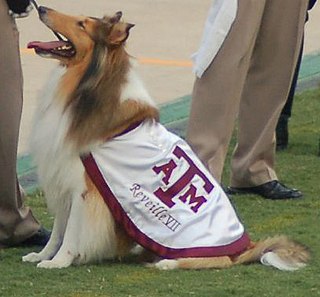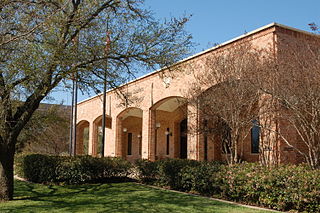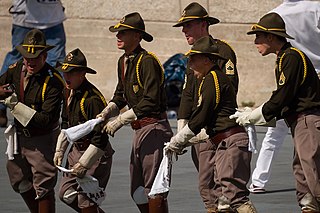
Texas A&M University is a public, land-grant, research university in College Station, Texas. It was founded in 1876 and became the flagship institution of the Texas A&M University System in 1948. Since 2021, Texas A&M has enrolled the largest student body in the United States, and is the only university in Texas to hold simultaneous designations as a land-, sea-, and space-grant institution. It is classified among "R1: Doctoral Universities – Very high research activity" and a member of the Association of American Universities.

The Texas A&M University Corps of Cadets is a student military organization at Texas A&M University. Established with the university in 1876, it is the oldest student organization on campus.

Aggie Muster is a tradition at Texas A&M University which celebrates the camaraderie of the university while remembering the lives of alumni who have died, specifically those in the past year. Muster officially began on April 21, 1903, as a day for remembrance of fellow Aggies. Muster ceremonies today take place in approximately 320 locations globally. The largest muster ceremony occurs in Reed Arena, on the Texas A&M campus. The "Roll Call for the Absent" commemorates Aggies, alumni and current students, who died that year. Alumni, family, and friends light candles and as they answer “here” when the name of their loved one is “called”. Campus muster also serves as a 50th-year class reunion for the corresponding graduating class. Some non-campus muster ceremonies do not include the pageantry of the campus ceremony, and might consist simply of a barbecue.

The Fightin' Texas Aggie Band is the official marching band of Texas A&M University. Composed of over 400 men and women from the school's Corps of Cadets, it is the largest military marching band in the world. The band's complex straight-line marching maneuvers are performed exclusively to traditional marches.
Texas A&M University at Galveston (TAMUG) is an ocean-oriented branch campus of Texas A&M University offering both undergraduate and graduate degrees. Students enrolled at Texas A&M University at Galveston, known affectionately as 'Sea Aggies', share the benefits of students attending Texas A&M University (TAMU) campus in College Station. TAMUG is located on Pelican Island, offering benefits for its maritime focused majors.

Reveille is the official mascot of Texas A&M University. Students adopted the first Reveille, a mixed-breed dog, in 1931. The cadets raised $100 during World War II to make Reveille a general, as part of a fundraiser for the K-9 Corps. Reveille is the highest-ranking member of the Texas A&M Corps of Cadets.

Public duties are performed by military personnel, and usually have a ceremonial or historic significance rather than an overtly operational role.
The Battalion is the student newspaper of Texas A&M University. Started in 1893 as a monthly publication, it continues to this day, now as a weekly print and daily online paper. The Battalion is entirely student-run and covers the university and surrounding Bryan-College Station area.

The traditions of Texas A&M University are a key aspect of the culture of Texas A&M University. Some of the school traditions date to the 1890s, shortly after the opening of the school, while others have been introduced more recently. These traditions encourage current students and alumni (Aggies) to cultivate the Aggie Spirit, a sense of loyalty and respect for the school, and dictate many aspects of student life, including how to greet others, how to act at an A&M sporting event, and what words a student may use in conversation. The most visible tradition among senior class students and alumni is the wearing of the Aggie Ring, whose design has been relatively unchanged since its introduction in 1894. Not all Aggie traditions are recognized by the university, and some, like Bonfire, have been discontinued for safety reasons. Texas Monthly states that the students' respect for school traditions and values is the university's greatest strength.

The history of Texas A&M University, the first public institution of higher education in Texas, began in 1871, when the Agricultural and Mechanical College of Texas was established as a land-grant college by the Reconstruction-era Texas Legislature. Classes began on October 4, 1876. Although Texas A&M was originally scheduled to be established under the Texas Constitution as a branch of the yet-to-be-created University of Texas, subsequent acts of the Texas Legislature never gave the university any authority over Texas A&M. In 1875, the Legislature separated the administrations of A&M and the University of Texas, which still existed only on paper.

The campus of Texas A&M University, also known as Aggieland, is situated in College Station, Texas, United States. Texas A&M is centrally located within 200 miles (320 km) of three of the 10 largest cities in the United States and 75% of the Texas and Louisiana populations. Aggieland's major roadway is State Highway 6, and several smaller state highways and Farm to Market Roads connect the area to larger highways such as Interstate 45.
Many terms are unique to, or hold a special meaning connected with, Texas A&M University in College Station, Texas. The university, often called A&M or TAMU, is a public research university and is the flagship institution of the Texas A&M University System. It opened in 1876 as the Agricultural and Mechanical College of Texas, the first public institution of higher education in that state. In 1963, the Texas Legislature renamed the school to Texas A&M University to reflect the institution's expanded roles and academic offerings. The letters "A&M" no longer have any explicit meaning but are retained as a link to the university's past.

The Texas A&M Singing Cadets are a male choral group at Texas A&M University. Nicknamed "The Voice of Aggieland", the Singing Cadets have been touring for 109 seasons, with their roots in a glee club founded on the A&M campus in 1893. The Singing Cadets are one of the oldest collegiate singing organizations in the world. They have toured both in America and abroad and have earned recognition by doing so, including invitations to sing for American presidents. Contrary to their name, the Singing Cadets are not all members of the Corps of Cadets and have not been since 1963, when the university as a whole ceased mandating Corps membership. Between 1996 and 2006, the Singing Cadets traveled over 35,000 miles and performed more than 450 concerts worldwide.

The Texas A&M Wind Symphony is a 63-member ensemble, representing "the finest wind and percussion players on the TAMU campus". The conductor of the Wind Symphony is Dr. Timothy Rhea and his assistant is Lt. Travis Almany. The band rehearses in the E.V. Adams Band Hall.

The Sam Houston Sanders Corps of Cadets Center is a museum on the campus of Texas A&M University in College Station, Texas, dedicated to the school's Corps of Cadets.

Mark Anthony Welsh III is the 27th president of Texas A&M University, former Dean of the Bush School of Government and Public Service at Texas A&M University, a retired United States Air Force four-star general, and a member of the board of directors of Northrop Grumman. Prior to his current role, he served as Chief of Staff of the United States Air Force and a member of the Joint Chiefs of Staff. He was appointed by President Barack Obama and confirmed by the United States Senate. Prior to that, General Welsh served as Commander of U.S. Air Forces in Europe, as the Associate Director for Military Affairs of the Central Intelligence Agency, and as the Vice Commander of Air Education and Training Command. In earlier portions of his career, he served as a fighter pilot and was a commander at the squadron, group and wing level, in addition to assignments in training, operations, intelligence and acquisitions. He also served as the Commandant of cadets of the United States Air Force Academy.

The MSC Student Conference on National Affairs (MSC SCONA) is an annual conference at Texas A&M University where students and military cadets from across Texas and the United States gather to exchange ideas and discuss the role of the United States in the global community. The most recent conference, MSC SCONA 68, was held in February of 2023.

At approximately 2:42 a.m. on November 18, 1999, the annual Aggie Bonfire at Texas A&M University collapsed during its construction, killing 12 people and injuring 27.

The Parsons Mounted Cavalry (PMC) is a cavalry unit of the Texas A&M Corps of Cadets which serves as the only mounted ROTC cavalry unit in the country. This horse combat unit consists of cavalry, artillery and quartermaster elements. The unit represents Texas A&M University at football games, parades, agricultural, and equestrian events throughout Texas. There are 90 junior and senior cadets and 50 horses in this unit.


















